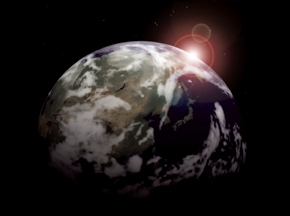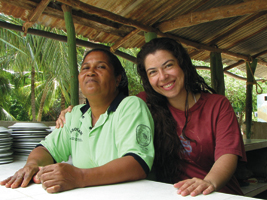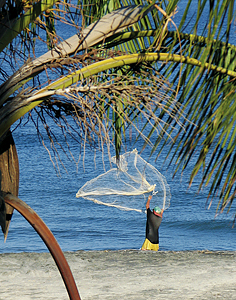Fisheries Science of the People, by the People,
for the People
EVEN AS A YOUNG GIRL growing up near Bogotá, Colombia, Lina Maria Saavedra Díaz felt the only effective way to solve environmental problems was through an integrated, interdisciplinary approach.
Though she might not have said it quite like that at the time, her strong beliefs held fast and, today, Díaz is a Ph.D. candidate in the Natural Resources and Earth Systems Science program at the University of New Hampshire.
“The type of integrated research I’m doing is what the NRESS program is all about,” Díaz says. “My focus is both environmental and social so on my Ph.D. committee I have a sociologist, a biologist, and a fisheries manager.”
For her doctorate, Díaz, who is a lecturer in marine ecology at the University of Magdalena in Colombia, is working with communities that practice artisanal or small-scale fishing on the Pacific and Atlantic coasts of her native Colombia.
These are hard times for the fishermen and their families whose very lives and way of life depends on what they’re able to catch from the sea using traditional, low-tech methods. For her study, Díaz will have to integrate the environmental, social, and economic aspects of these subsistence communities in an effort to, eventually, help them help themselves.
“There are many differences between the two coasts, like species of fish and types of gear used. But basically the fishermen all have the same problems. Their livelihoods are threatened and fisheries are becoming fragile due to overexploitation,” Díaz says.
Díaz will spend portions of the next two years living in four fishing villages on the Pacific coast and five on the Atlantic after each community has been carefully evaluated from an environmental, social, and economic standpoint.
The work she is doing is very much nontraditional fisheries science, and is not without its risks. In some cases she will work in communities that are inaccessible by road and live in a tent—an “outsider” working alone.
“It can be tough gaining their trust, and even more so because I am a woman and white–many of the fishermen are of African descent,” Díaz says. “They are good people but to build trust will take time. And while I hope it doesn’t happen, I’m open to being rejected.”
Building trust aside, Díaz stresses that the fate of her research is in the hands of the fishermen and, in fact, they themselves will be doing the research. “This project will be based on local, traditional knowledge—knowledge that fishermen have built through living and working. They know more than any fisheries expert–they know who is fishing, when to fish, what problems they are facing. They have the knowledge we don’t have. We’re not going in there to ‘save’ them,” she says.
The ultimate goal of Díaz’s research is to help local communities and the appropriate Colombian government agencies adopt a community-based management fisheries plan. This co-management style is not the typical top-down bureaucracy but, rather, involves local fishermen and government agencies as equal management partners. Such an approach has been tried with some success in the Philippines and Vietnam. Díaz’s work is in a very real sense setting the stage for this eventual cooperation.
So with a fully vetted survey in hand, Díaz is sitting down with fishermen and community members to assess their situations; what is happening to their local fisheries, what are their methods of fishing, what types of equipment do they use, what problems are they having, and what kinds of solutions might help?
“If you look in the literature there are just a few standout studies on artisanal communities because not too many people work successfully in these places,” says Andy Rosenberg, director of EOS’s Ocean Process Analysis Laboratory and one of Díaz’s advisors.
Rosenberg says that in a traditional fisheries science investigation researchers would go collect a wealth of biological fisheries data and then talk to the people involved later.
“What Lina’s doing instead is trying to do this with traditional knowledge, and that’s just very appealing. You have to be really committed to going back and talking to people, listening to them, trying to figure out what’s next, and she can do that because she’s deeply attached to her country,” Rosenberg adds.
Díaz is also “intensely motivated,” according to Rosenberg–so much so that she successfully competed in the 2008 UNESCO-L’ORÉAL Women in Science Fellowship program becoming one of just 15 young women researchers worldwide to be awarded a two-year fellowship.
In a sense, Díaz’s work is that of a diplomat as well as scientist; once she has gathered her data, part of her job will be convincing villagers to adopt new practices that might save or restore their depleted fisheries.
For example, her studies might suggest that closing a specific area to fishing for a time could help restore a certain species, or changing the type of fishing gear used might similarly help turn things around. Difficult ideas to sell, of course.
“The people are just trying to survive. I understand that, but the resources are endangered and, ultimately, the fishermen’s lifestyles are endangered if we don’t do something,” Díaz says.
In such an instance, a co-management approach could be the difference between success and failure. If, for example, the villagers agreed to close a certain area to fishing for a time it would require that the government enforce the closure.
But, Díaz emphasizes, the key to the co-management approach is to empower villagers to use solutions based on their own fishing practices and the social needs of their community–along with some help from modern-day scientific technologies and government assistance.
“The idea is for the people to start making decisions that allow them to use the resources wisely. With co-management, the villagers will continue to do what they’ve always done, there will just be some agreed-upon rules that will benefit everybody in the long run,” says Díaz.
Though she might not have said it quite like that at the time, her strong beliefs held fast and, today, Díaz is a Ph.D. candidate in the Natural Resources and Earth Systems Science program at the University of New Hampshire.
“The type of integrated research I’m doing is what the NRESS program is all about,” Díaz says. “My focus is both environmental and social so on my Ph.D. committee I have a sociologist, a biologist, and a fisheries manager.”
For her doctorate, Díaz, who is a lecturer in marine ecology at the University of Magdalena in Colombia, is working with communities that practice artisanal or small-scale fishing on the Pacific and Atlantic coasts of her native Colombia.
Lina Maria Saavedra Díaz (right) with Letilina Curvelo de Mejia, who runs a restaurant that dpends on her husband's artisanal fishing catch.Photo:Lina Maria Saavedra Díaz |
“There are many differences between the two coasts, like species of fish and types of gear used. But basically the fishermen all have the same problems. Their livelihoods are threatened and fisheries are becoming fragile due to overexploitation,” Díaz says.
Díaz will spend portions of the next two years living in four fishing villages on the Pacific coast and five on the Atlantic after each community has been carefully evaluated from an environmental, social, and economic standpoint.
The work she is doing is very much nontraditional fisheries science, and is not without its risks. In some cases she will work in communities that are inaccessible by road and live in a tent—an “outsider” working alone.
“It can be tough gaining their trust, and even more so because I am a woman and white–many of the fishermen are of African descent,” Díaz says. “They are good people but to build trust will take time. And while I hope it doesn’t happen, I’m open to being rejected.”
Building trust aside, Díaz stresses that the fate of her research is in the hands of the fishermen and, in fact, they themselves will be doing the research. “This project will be based on local, traditional knowledge—knowledge that fishermen have built through living and working. They know more than any fisheries expert–they know who is fishing, when to fish, what problems they are facing. They have the knowledge we don’t have. We’re not going in there to ‘save’ them,” she says.
A fisherman casts a net from the shoreline near Santa Marta on the Colombian Caribbean coast. Photo:Lina Maria Saavedra Díaz |
The ultimate goal of Díaz’s research is to help local communities and the appropriate Colombian government agencies adopt a community-based management fisheries plan. This co-management style is not the typical top-down bureaucracy but, rather, involves local fishermen and government agencies as equal management partners. Such an approach has been tried with some success in the Philippines and Vietnam. Díaz’s work is in a very real sense setting the stage for this eventual cooperation.
So with a fully vetted survey in hand, Díaz is sitting down with fishermen and community members to assess their situations; what is happening to their local fisheries, what are their methods of fishing, what types of equipment do they use, what problems are they having, and what kinds of solutions might help?
“If you look in the literature there are just a few standout studies on artisanal communities because not too many people work successfully in these places,” says Andy Rosenberg, director of EOS’s Ocean Process Analysis Laboratory and one of Díaz’s advisors.
Rosenberg says that in a traditional fisheries science investigation researchers would go collect a wealth of biological fisheries data and then talk to the people involved later.
“What Lina’s doing instead is trying to do this with traditional knowledge, and that’s just very appealing. You have to be really committed to going back and talking to people, listening to them, trying to figure out what’s next, and she can do that because she’s deeply attached to her country,” Rosenberg adds.
Díaz is also “intensely motivated,” according to Rosenberg–so much so that she successfully competed in the 2008 UNESCO-L’ORÉAL Women in Science Fellowship program becoming one of just 15 young women researchers worldwide to be awarded a two-year fellowship.
In a sense, Díaz’s work is that of a diplomat as well as scientist; once she has gathered her data, part of her job will be convincing villagers to adopt new practices that might save or restore their depleted fisheries.
For example, her studies might suggest that closing a specific area to fishing for a time could help restore a certain species, or changing the type of fishing gear used might similarly help turn things around. Difficult ideas to sell, of course.
“The people are just trying to survive. I understand that, but the resources are endangered and, ultimately, the fishermen’s lifestyles are endangered if we don’t do something,” Díaz says.
In such an instance, a co-management approach could be the difference between success and failure. If, for example, the villagers agreed to close a certain area to fishing for a time it would require that the government enforce the closure.
But, Díaz emphasizes, the key to the co-management approach is to empower villagers to use solutions based on their own fishing practices and the social needs of their community–along with some help from modern-day scientific technologies and government assistance.
“The idea is for the people to start making decisions that allow them to use the resources wisely. With co-management, the villagers will continue to do what they’ve always done, there will just be some agreed-upon rules that will benefit everybody in the long run,” says Díaz.
by David Sims, Science Writer, Institute for the Study of Earth, Oceans, and Space. Published in Spring 2008 issue of EOS .


